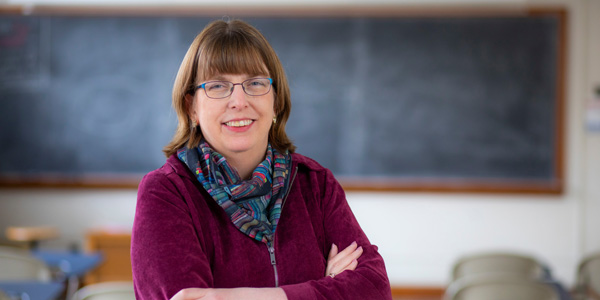
Preparing the Next Generation to Predict Pandemics
When Nancy Boury introduced the class, Predicting the Next Pandemic, in fall 2019 she had no way to foresee how timely the topic would soon become.
Boury, assistant professor of plant pathology and microbiology at Iowa State University, first envisioned the course several years ago, when her interest was piqued by a presentation at an American Society for Microbiology educators meeting. “The idea stuck in my mind,” she says.
In 2019, she had the chance to use the idea to create a short, introductory course for students interested in STEM fields. She worked with graduate students, Chloe Wasendorf and Brian Macias-Musco, to plan the half-semester course, Micro 265X. It launched in person last fall. Just a few months later, the class migrated online in response to a real-time, full-blown pandemic spreading over the globe.
ONE HEALTH PARADIGM
Boury designed her class around the interdisciplinary One Health paradigm endorsed by national and international health organizations, ranging from the American Veterinary Medical Association to the U.S. Centers for Disease Control and Prevention to the World Health Organization.
“The concepts I’m teaching are both new and really old,” Boury says. “While the paradigm is fairly new, it is based on more than a century of experience and data that show the interconnectedness of human health with animal and environmental health.”
The course begins with readings about disease outbreaks and the scientific detective work to identify and overcome them. Students read case studies of different types of viral and bacterial diseases that have plagued humans over time, including Parrot Fever in the 1920s, Q Fever, Lyme Disease and malaria.
HOW SCIENCE HAPPENS
The trajectory of the course was modified in Spring 2020 to include discussion of a new emerging disease, the novel coronavirus, COVID-19.
“This topic provides excellent opportunities to help students think about how science happens,” Boury says. “Students learn the process of microbiology is not as easy and straightforward as people might think. There is a lot of mystery involved. We talk about how the work of a microbiologist changes in different situations, as scientists go through the steps to identify a disease, look for its means of transmission, develop and test a vaccine and devise other measures for prevention or treatment.”
The course also brings in issues of communications and policy, which are important to the whole process of addressing disease threats and managing risks, according to Boury.
“A lot of the class is focused on thinking about how to systematically and objectively ask good questions,” she says.
MOST RELEVANT CLASS
Hannah Heit, a senior in animal science, one of the students to take Boury’s Micro 265X, plans to pursue advanced degrees in public health and veterinary medicine.
“The course allowed me to learn more about careers I will be able to pursue with those degrees,” she says. “It was very intriguing because we were able to apply what we learned in class to what was happening in the world. This class showed me how we live in a One Health world where humans’ actions — from deforestation to eating bush meat — can propagate the spread of new diseases.”
Emily Nejdl, a senior in industrial engineering, says the course was the most relevant class of her entire college career.
“The topics I learned in this class were immediately applicable to life. Although COVID-19 continues to be very serious,” she says, “having a basic understanding of One Health principles allowed me to approach it from a more scientific perspective rather than one solely of fear and anxiety.”
MORE THAN PANDEMICS
In addition to teaching students how to ask good questions about health and science, Boury has a research interest in how to effectively teach habits that lead to success in college. This shows up in all her courses as lessons in time management, writing and evaluating credible references. Her last pandemic class assignment requires students to use those skills for a mini-grant proposal, posed as if they were going to research a current health problem and conduct a project that would contribute to a solution.
“Someday, one or more of these students could be in a position to make decisions related to a future pandemic, and they will be a little
more prepared,” Boury says. “In the meantime, I hope it helps them become better students who are more excited about the nature of science.”



